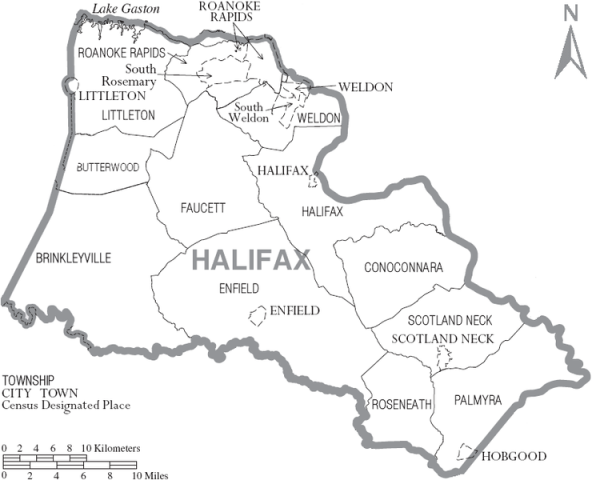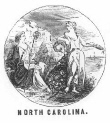|

In 1758 the residents of
Edgecombe County petitioned the Governor and the Colonial Assembly
requesting that the parish of Halifax be granted the status of an
individual county - having functioned along with St. Mary’s Parish as
the two original Edgecombe County parishes since its creation in 1741
from the southwestern section of Bertie County. Bertie County was formed
from the western extension of Chowan Precinct (west of the Chowan River)
in the year 1722, and was even earlier, an undefined part of the now
extinct original Albemarle County 1664-1668. All territory within the
boundaries of Edgecombe County north of the Fishing Creek and Rainbow
Banks on the Roanoke River - approximately 711 square miles - was
officially designated as Halifax County on January 1, 1759. Halifax
County is located in the northeastern area of North Carolina and is
bordered on all sides by seven neighboring NC counties. As suggested by
Governor Author Dobbs, Halifax was named for George Montague II, Earl of
Halifax, first Lord of the Board of Trade and Plantations. The county
seat, also named Halifax (town) had been established in 1757 on the
Roanoke River. Located on the fall line of the Piedmont and Coastal
Plain, the county has an interesting mixture of flat and hilly terrain
and an excellent climate for agricultural pursuits. The original
residents of this area along the southern banks of the Moratuck
[Roanoke] River and Quankie Creek were the Tuscarora Indians.
In 1917 Milton Whitney, Chief of Bureau, U. S. Department of Agriculture
submitted an official report to the US Government in which he stated
that the early settlers of the Halifax County area came mainly from the
British Isles. Many of them settled first in New Jersey and other
northern States and then migrated to this county. Others came directly
to Halifax County. The first settlements in Halifax County were
apparently made near the watercourses. The first crops grown were corn,
peas, potatoes, flax, and various vegetables. Live stock was brought in
at an early date, and gradually increased in number. Flax was spun and
woven into garments for home use. Considerable wool was produced and
made into clothing at home. Tanneries were in operation at an early
date, and furnished leather for making shoes. Nearly every settler grew
tobacco for domestic use. Cotton was grown in small patches and made
into homespun garments, the lint being separated from the seed by hand.
|
|
In 1774, the southeastern part of Halifax County was combined with part of Tyrrell County to form Martin
County. Today Halifax County is comprised of twelve townships with a total population of 57,370 people (2000 Census). The Townships are:
Brinkleyville, Butterwood, Conoconnara, Enfield, Faucett, Halifax, Littleton, Palmyra, Roanoke Rapids, Roseneath, Scotland Neck, and Weldon.

|
|
An Act for dividing Edgecomb County.
I. Whereas divers inconveniences attend the Inhabitants of Edgecomb County, by reason of the large extent thereof, and the great Distance that many of them
live from the Court House, and other Places usually appointed for Public Meetings;
II. Be it therefore Enacted, by the Governor, Council, and Assembly, and by the Authority of the same, That from and immediately after the First Day of
January next ensueing, the said County of Edgecomb be divided, by the dividing Line between the Parish of Edgecomb and the Parish of St. Mary; and that that
Part of the said County which is now the Parish of St. Mary, remain, be called, and known by the Name of Edgecomb County; and that that Part of the said
County which is now the Parish of Edgecomb, be thence forth erected into one distinct County, and called and known by the Name of Halifax.
III. And for the due Administration of Justice, Be it further Enacted, by the Authority aforesaid, That after the said first Day of January, a Court for the
said County of Edgecomb be constantly held, by the Justices thereof, at Redman's Oldfield, on Tyoncoca, upon the Days and Times by Law appointed for that
purpose; and also that a Court for the said County of Halifax be constantly held, by the Justices thereof, at Enfield, upon the first Tuesdays in March,
June, September, and December, in every Year, as by the Laws of this Province is Provided, and shall be, by Commission to the Justices of the said Counties,
respectively, directed.
IV. And be it further Enacted, by the Authority aforesaid, That nothing herein contained shall be construed to debar the Sheriff of the said County of
Edgecomb, as the same stands now undivided, to make Distress for any Levies, Fees, or other Dues, that shall be due from the Inhabitants of the said County
on the said First Day of January, in the same Manner as by Law the said Sheriff could or might have done if the said County had remained undivided; and the
said Levies, Fees, and other Dues, shall be collected and accounted for in the same Manner as if this Act had never been made; any Thing herein contained to
the contrary notwithstanding.
V. Be it further Enacted, by the Authority aforesaid, That after the said First Day of January, the said County of Halifax shall be, continue, and remain
part of the District Supreme Court of Justice, Oyer and Terminer, and General Gaol Delivery, usually held for the Counties of Northampton, Edgecomb, and
Granville; and the Sheriff or Collector of the said County of Halifax shall, from Time to Time account for and pay to the Public Treasurer of the Northern
District of this Province for the Time being, all Public Levies by him Collected, or wherewith he shall stand Chargeable, in the same Manner, and under the
like Pains and Penalties, as other Sheriffs.
VI. Provided always, That nothing herein contained shall be construed, deemed or taken, to alter or derogate from the Rights and Royal Prerogative of his
Majesty, his heirs or Successors of granting Letters of Incorporation to the said Counties, and of ordering, appointing, and directing the Election of a
Member or Members to represent them in Assembly, and of granting Markets and Fairs to be kept and held in them respectively; but that the said Right and
Prerogative shall and may, at all Times hereafter, be exercised therein by his said Majesty, his Heirs or Successors, in as full and ample manner, to all
Intents and Purposes whatsoever, as if this Act had never been made. (The Laws of North Carolina
1758, Pg. 496-497, Chapter XIII) |



